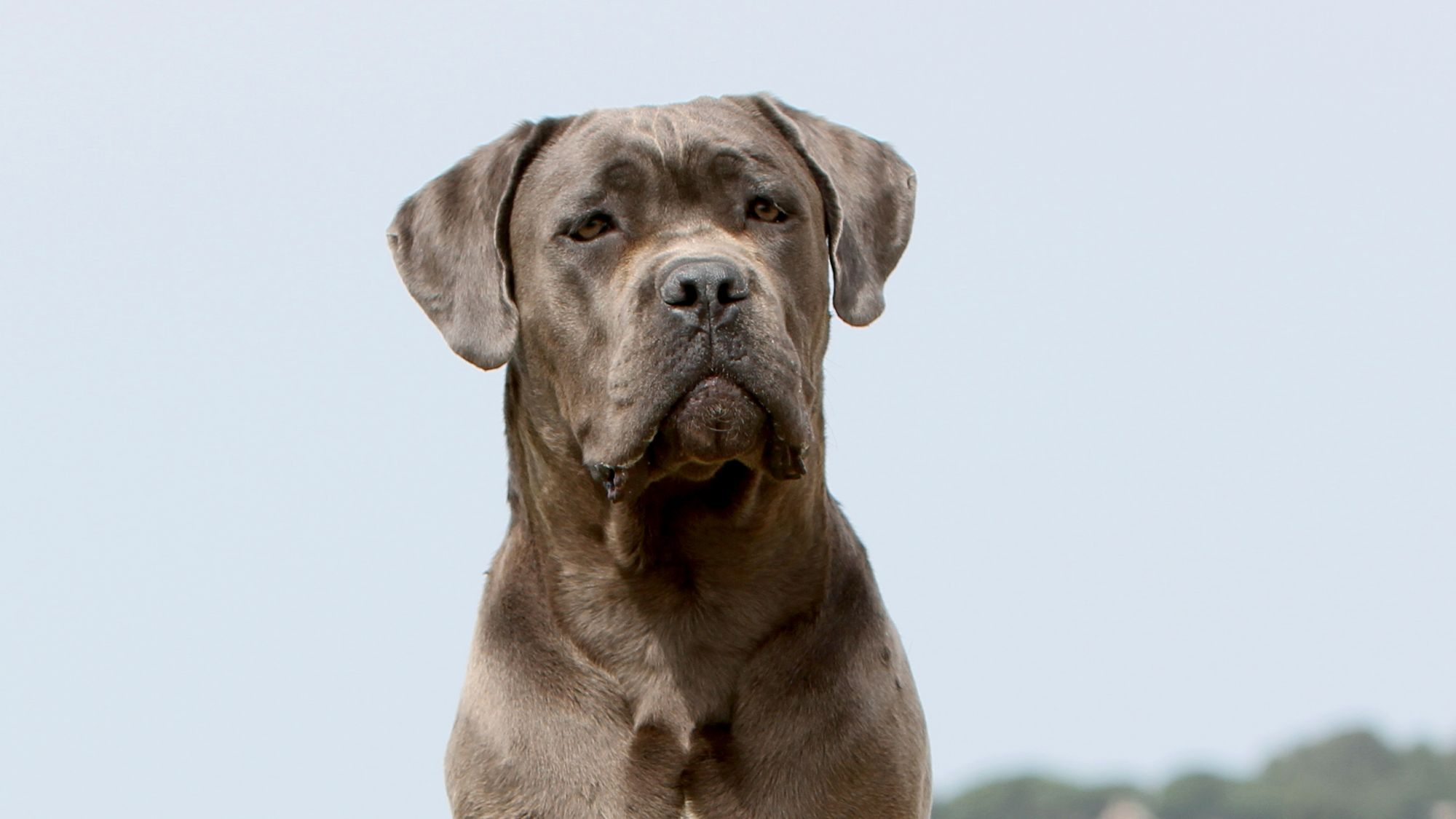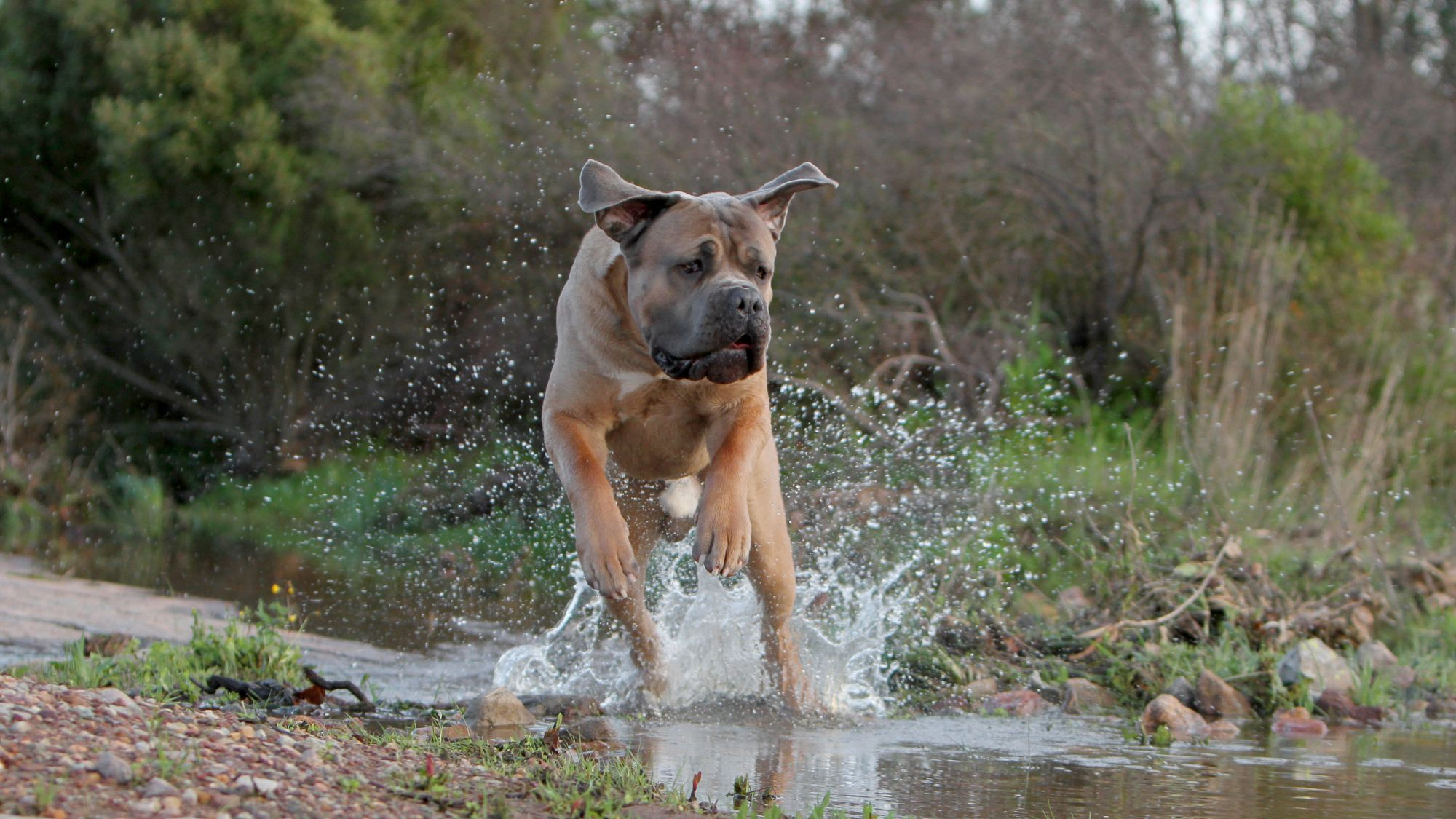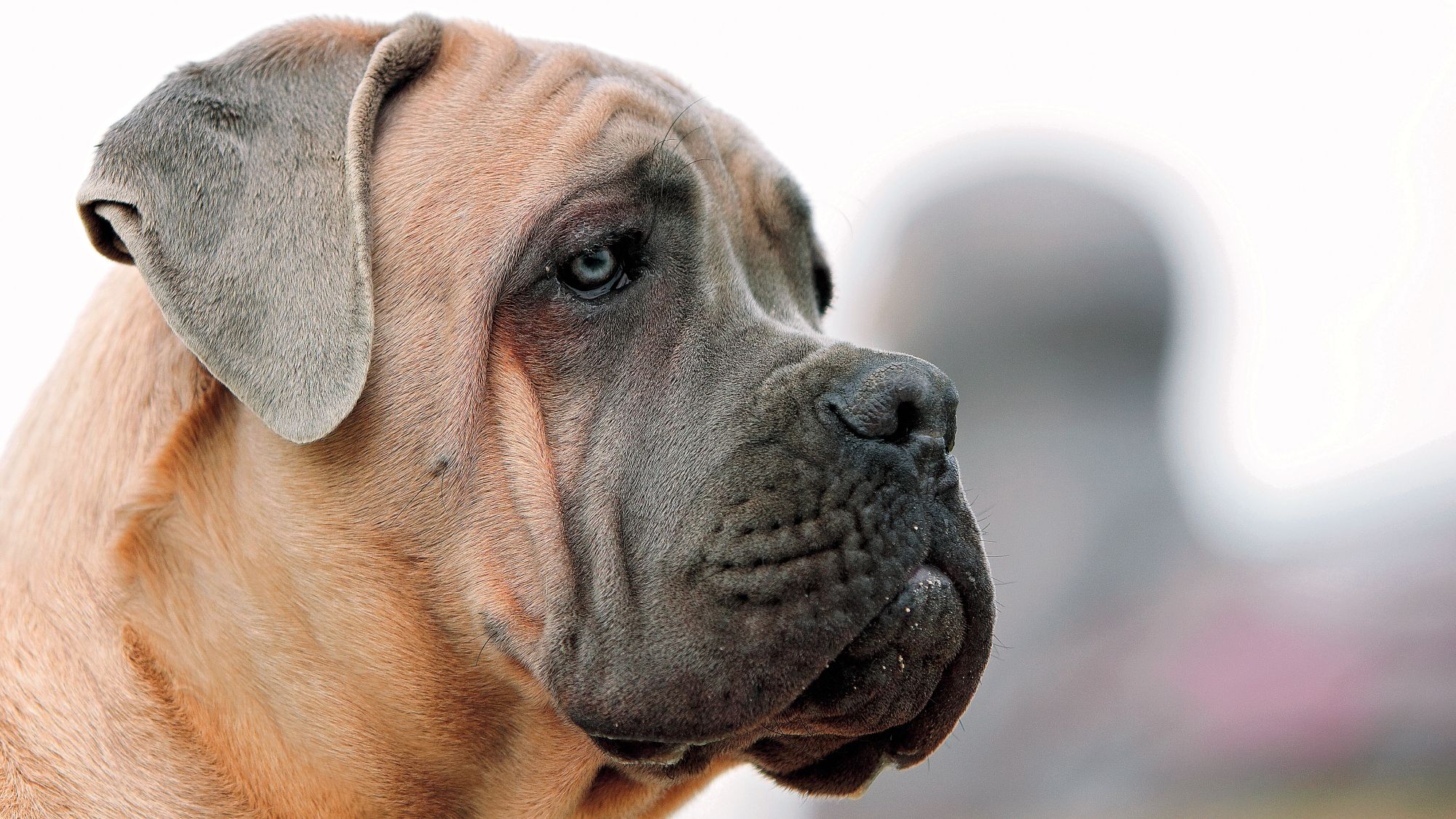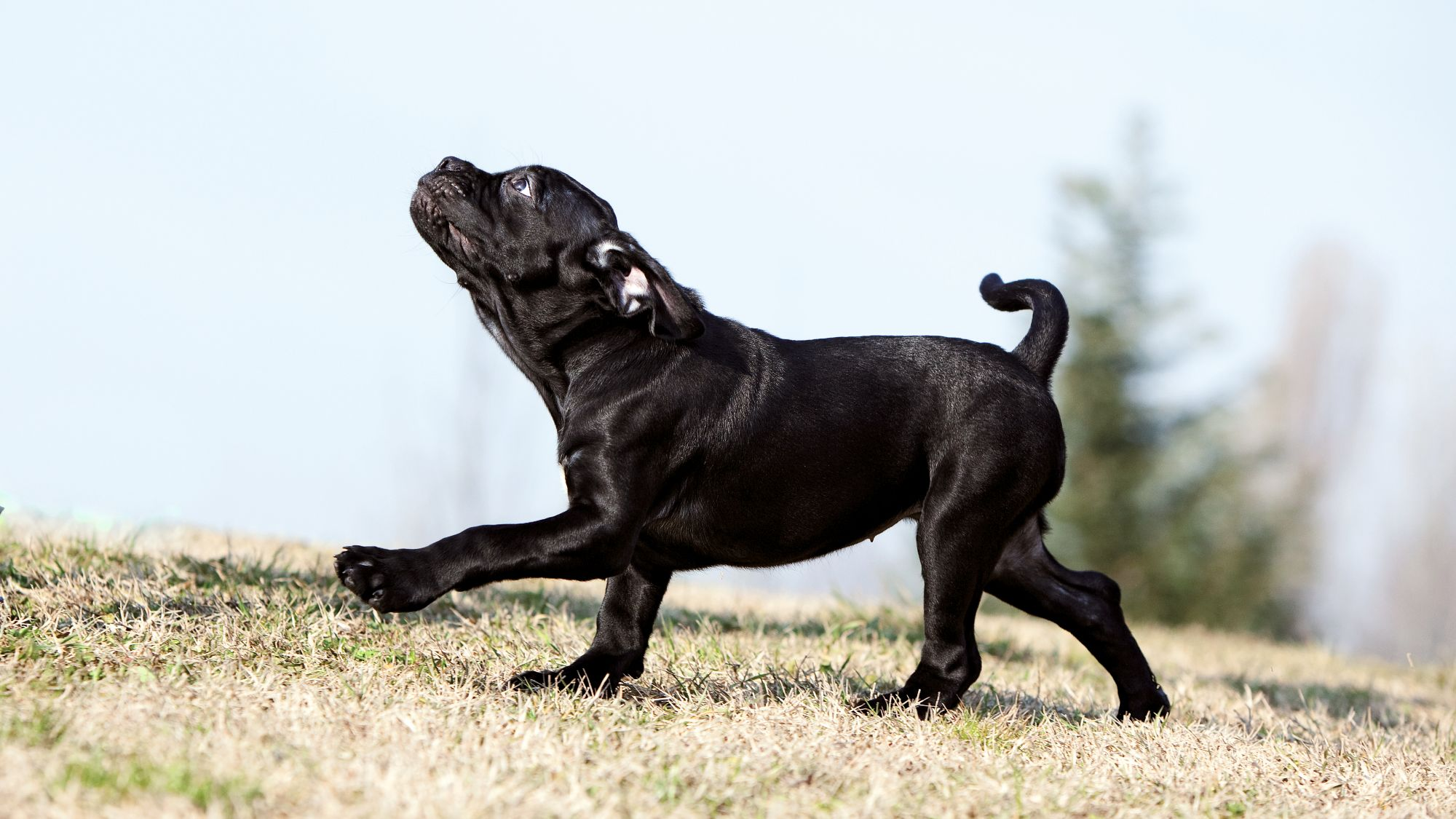Let's talk Cane Corsos
A majestic breed if there ever was one, the Cane Corso is a faithful companion and fearless protector. Always eager and devoted, the breed’s incredibly muscular body combined with a keen temperament makes them a superb watchdog - their name translates roughly from Latin as ‘bodyguard dog.’ And yes, they will always love you. Their nonchalant gaze transmits a cool confidence but make no mistake: beneath that tough exterior lies a sweet sentimental sort.
Official name: Cane Corso
Other names: Cane Corso Italiano, Italian Court Dog
Origins: Italy
Drooling tendencies
2 out of 5Shedding Level
3 out of 5Energy level*
5 out of 5Compatibility with other pets
4 out of 5Warm weather?
3 out of 5Suited to apartment living
2 out of 5Family pet?*
5 out of 5Can be left alone
2 out of 5
| Male | Female |
|---|---|
| Height | Height |
| 25 - 30 in | 23 - 26 in |
| Weight | Weight |
| 100 - 110 lb | 88 - 100 lb |
| Life stages | |
|---|---|
| Puppy | Adult |
| 2 to 15 months | 15 months to 5 years |
| Mature | Senior |
| 2 to 5+ years | From 8+ years |
| Baby | |
| Birth to 2 months | |
Drooling tendencies
2 out of 5Shedding Level
3 out of 5Energy level*
5 out of 5Compatibility with other pets
4 out of 5Warm weather?
3 out of 5Suited to apartment living
2 out of 5Family pet?*
5 out of 5Can be left alone
2 out of 5
| Male | Female |
|---|---|
| Height | Height |
| 25 - 30 in | 23 - 26 in |
| Weight | Weight |
| 100 - 110 lb | 88 - 100 lb |
| Life stages | |
|---|---|
| Puppy | Adult |
| 2 to 15 months | 15 months to 5 years |
| Mature | Senior |
| 2 to 5+ years | From 8+ years |
| Baby | |
| Birth to 2 months | |
Tailored nutrition for your Cane Corso

Get to know the Cane Corso
All you need to know about the breed
Despite their slightly intimidating presence, the Cane Corso is gentle to the bone. A hugely loyal companion who is incredibly eager to please, they are a mastiff type of breed - characterized by a substantial body, large feet, bulky head, and a brachycephalic front, which means a shortened muzzle and nose.
Developed for big-game sport and used to being assertive, Corsi - as they’re known in the plural - are quite intelligent, so will need a serious, assertive owner. Showing the breed who is in charge from early on is important. Large guardian dogs like the Cane Corso require socialization with family and friends to achieve the most even temperament.
The breed is one to compete in tracking, agility, obedience, and protection sport. The Cane Corso’s admirable traits are plenty, and the need for exercise is chief among them. Two walks a day at minimum are best, a run even better if you are so inclined. This is not a dog that sits still! The breed thrives in a home with land or a large yard.
As wonderful a family dog as the Cane Corso is, they are not one to take to others so quickly. The dog is very devoted to their owners and hesitates when bonding with others. Get them used to family and friends early on to bring out the best traits of your Cane Corso.

Two facts about Cane Corsos
1. Keep mealtime calm
Large breeds like the Cane Corso may be prone to a condition called gastric dilatation and volvulus - GDV - or most commonly called bloat. The condition, often abrupt, can happen after a too-quick meal where the stomach turns and fills with gas. Seek medical attention right away if it does occur as it is treatable but can be fatal. Any swelling, restlessness, or sudden discomfort are signs of GDV. Regular vet visits and careful feeding are great preventative measures.
2. Lives to work
A dog like the Cane Corso needs to be occupied during waking hours. They benefit tremendously from taking on needed tasks around the house - if in a more domestic situation - or guarding property or livestock if in a farming or agricultural one, as guardianship is second-nature to him. This is one dog who is highly loyal to their owners and to the homefront.

History of the breed
The stunning Cane Corso has long been seen as a dignified breed, with roots in his home country of Italy enough to cement his sophistication. His history there dates to ancient Rome. He is a Molosus subcategory of working breed, thought to descend from the ancient Greek Molossi tribe which bred powerful, large mastiff-type dogs. When the Roman Empire reigned supreme over Greece, native Italians brought the dogs home to further develop them.
The Cane Corso’s ancestors - thought to be even bigger and fearless - were used mainly for battle. As Italy’s wartime endeavours faded, the Cane Corso was utilised over centuries to guard farms and for sport. With the onset of industrialization, the Corsi’s numbers dwindled and by the mid-Twentieth Century, they were all but extinct.
Thanks to a group of enthusiastic fanciers, the Cane Corso breed survived, hitting U.S. shores in 1988 and recognised by the AKC in 2010.
From head to tail
Physical characteristics of Cane Corsos
1.Ears
2.Head
3.Body
4.Coat
5.Tail

Things to look out for
From specific breed traits to a general health overview, here are some interesting facts about your Cane Corso
Intensity in more ways than one
Although the Cane Corso may have a formidable presence, they are incredibly affectionate dogs, with an unbridled devotion to their owners. Their lively and alert face gives off the allegiance found within and they have been described as having a huge heart. Keep that in mind during training when it’s better to use gentle repetition than overly rigid decrees.
Did you just snort?
One of the more charming, and surprising, traits of the Cane Corso dog is their communicative ability - which comes more in the way of sounds and verbalizations than in traditional barks. Tough though they may look, it’s fairly funny when the breed tries to get something across, often done in blips and blurts – and sometimes snorts – instead of what one might expect. It’s just another thing that makes this amiable and elegant breed extra special.
Tailored nutrition for Cane Corso

When choosing food for a Cane Corso, there are many factors to consider: their age, lifestyle, activity level, physical condition, and health including potential sickness or sensitivities. Food provides energy to cover a dog’s vital functions, and a complete nutritional formula should contain an adjusted balance of nutrients to avoid any deficiency or excess in their diet, both of which could have adverse effects on the dog. As giant-sized breed dogs have a higher risk of a condition called gastric dilatation volvulus (GDV), where the stomach becomes overstretched and rotated because of excess gas, it’s recommended to split the daily allowance into three meals for puppies and try to keep this routine into their adult years. There are a number of causes responsible for GDV.
Strong Immune System
Supports the development of the puppy's healthy immune system with the inclusion of clinically proven antioxidants, including vitamins E and C.
Intense Growth Stage - Controlled Energy
This formula supports your giant breed puppy's unique nutritional needs from 2 to 8 months and helps avoid excess weight gain.
Microbiome Support
Combination of prebiotics & highly digestible proteins to help promote a healthy balance of intestinal bacteria for digestive health.

As with many giant-sized breed dogs, Cane Corsos are prone to digestive sensitivity, and their body weight can create stress on their joints throughout their lifetime. Cane Corso’s nutritional needs then should include high quality protein and a balanced supply of dietary fibre to help promote optimal digestibility, as well as glucosamine, chondroitin, and antioxidants to help support the health of their bones and joints. A formula enriched with omega-3 fatty acids, such as EPA-DHA, will help maintain healthy skin. An adapted taurine content is also important to support healthy heart function.
Strong Immune System
Supports the development of the puppy’s healthy immune system with the inclusion of clinically proven antioxidants, including vitamins E and C.
Muscle Development Stage
As your giant breed puppy gains more muscle during the final growth stage, an adapted protein content helps support muscle development from 8 to 18/24 months old.
Microbiome Support
Combination of prebiotics & highly digestible proteins to help promote a healthy balance of intestinal bacteria for digestive health.

As with many giant-sized breed dogs, Cane Corsos are prone to digestive sensitivity, and their body weight can create stress on their joints throughout their lifetime. Cane Corso’s nutritional needs then should include high quality protein and a balanced supply of dietary fibre to help promote optimal digestibility, as well as glucosamine, chondroitin, and antioxidants to help support the health of their bones and joints. A formula enriched with omega-3 fatty acids, such as EPA-DHA, will help maintain healthy skin. An adapted taurine content is also important to support healthy heart function.
Healthy Mobility
A combination of minerals and nutrients to support the extra demands on a giant dog's bones and joints.
Vitality Support
Supports heart, kidney and brain health.
Digestive Health
Easy-to-digest, high-quality proteins, plus fibers and prebiotics to promote optimal stool quality.

Caring for your Cane Corso
Exercise, grooming and training.
7/7
All about Cane Corsos
The Cane Corso dog is a physically powerful breed. New owners should more than likely be experienced with dog ownership as well as handling a larger animal. Proper training is essential to bringing out the best in the Cane Corso breed.
Leave it to the Italians to invent another noble and sophisticated product, this time in the form of a canine. Although cross-bred over the years to develop their better characteristics, there are no two breeds that the Cane Corso draws upon. The dog hails originally from ancient Rome, used for war and security.
Suggested Breeds
Read more on this topic
Sources
- Veterinary Centers of America https://vcahospitals.com/;
- Royal Canin Dog Encyclopaedia. Ed 2010 and 2020
- Banfield Pet Hospital https://www.banfield.com/
- Royal Canin BHN Product Book
- American Kennel Club https://www.akc.org/
Like & share this page